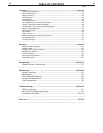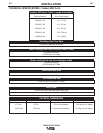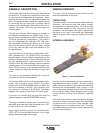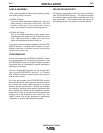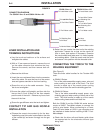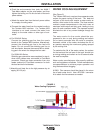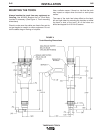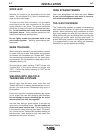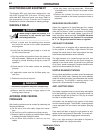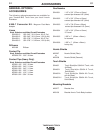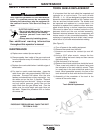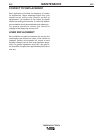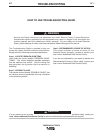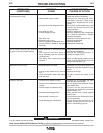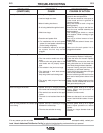
B-1
OPERATION
TANDEM MIG TORCH
B-1
ELECTRODES AND EQUIPMENT
TheTandem MIG torch has been designed for use
with 0.035" through 5/64" (0.9 mm to 1.9 mm) Lincoln
solid steel MIG wires and metal core wires. Refer to
the appropriate Lincoln Process and Procedure
Guidelines for further information on welding settings.
MAKING A WELD
• When using an open arc process, it is
necessary to use correct eye, head
and body protection.
------------------------------------------------------------------------
a) Check to make sure the welding power sources
are turned on and set to the correct parameters
and programs.
b) Verify that the shielding gas supply is on and set
for the correct flow rate.
c) Set the preflow and postflow times the same on
both wire feeders. Make sure the post flow is long
enough to provide shielding during any crater fill
operation.
d) Check that all of the water coolers are operating
properly.
e) If applicable, make sure the Air-Blast spray sys-
tem is on.
f) Position the torch over the joint.
• Automatic equipment may start unexpectedly.
------------------------------------------------------------------------
g) Make a weld by sending a trigger signal to the
welding power sources.
AVOIDING WIRE FEEDING
PROBLEMS
Wire feeding problems can be avoided by observing the
following procedures:
a) Do not use a torch with cables longer than neces-
sary.
b) Do not kink or pull the cable around sharp corners.
c) Keep the cable as straight as possible when welding
or loading electrode through the cable.
d) Do not allow dolly wheels or trucks to run over
cables.
e) Use only clean, rust-free electrodes. Electrodes
manufactured by Lincoln Electric have proper surface
lubrication.
f) Replace the contact tips when the arcs start to
become unstable or the contact tip ends are fused or
deformed.
SHIELDING GAS DELIVERY
Adjust flow regulators for prescribed gas flow. Inspect
hoses regularly for worn or torn hoses. Perform a soapy
water test on hoses if a leak is suspected. Avoid kinking
or collapsing hoses with cable clamps. Insure that dif-
fuser is properly seated and tight. For G3494-XA series
torch, two gas sources are required. Do not attempt
to “Y” or Tee gas from one flow meter or regulator.
AIR BLAST CLEANING
The welding torch is equipped with a separate gas hose
for the purpose of providing a high pressure air blast
through the nozzle area to clear loose spatter that may
have accumulated between the two diffusers.
The high-pressure air is routed through the torch over
molded assembly and exits into the nozzle through an
opening in the nozzle shield. Air should be dry and free
of oil or anti- spatter compound. Pressure should be ade-
quate to free loose spatter (50-100 psi).
NOZZLE REAMING STATIONS
During robotic applications a reamer should be employed
to keep the nozzle clean. Reaming the nozzle between
welds will reduce the down time associated with manual
torch cleaning. The M18426-1 reaming station is an
option that is recommended for nozzle cleaning.
ANTI- SPATTER SPRAY
Anti-spatter compound may be used to keep weld spatter
from accumulating in the nozzle. Anti-spatter should not
be applied through the air blast line. Only dry air should
be used for air blast functions.
Anti-spatter may be applied to the interior of the nozzle
from an external sprayer. The M18426-1 reaming station
comes equipped with an external anti-spatter spraying
station.
Care should be taken to apply the right amount of anti-
spatter to the internal area of the nozzle. Too much anti -
spatter will cause diffuser clogging and weld porosity.
Only a very light covering of anti-spatter is required to
keep the spatter from cling to the nozzle.
WARNING
WARNING



